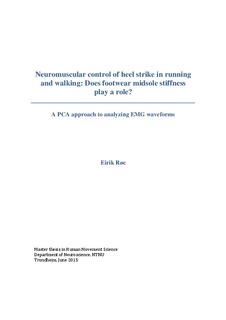| dc.description.abstract | The current study had two main purposes. The first aim was to determine whether the
findings from a previous study that found waveforms that could be related to
mechanisms for feedback and feed-forward muscle activation in walking, by applying
Principal Component Analysis (PCA) on the Electromyography (EMG) signals from
muscles controlling the knee, could be reproduced in a second independent dataset.
Furthermore, it was investigated if similar waveforms also could be found in muscles
controlling the ankle joint, and that they would play a role in controlling the heel
strike not only in walking but also in running.
The second aim was to get a better understanding of how the neuromuscular system
adapts to specific heel strike conditions. This was done by systematical change the
cushioning properties of a running shoe. It was hypothesized that the different shoe
conditions would affect to what extend the characteristic feedback or feed-forward
patterns would contribute to the muscle activation amplitude.
The study was conducted by having ten subjects walk and run with five
different running shoes with different cushioning properties. EMG signals from
muscles controlling the knee and ankle joint were collected while the subjects were
walking and running. A PCA was conducted on the collected EMG signals, providing
Principal Components (PCs) showing characteristic waveforms. Furthermore the
effect of each shoe on these waveforms was found by statistical analysis.
The results from this study showed that waveforms that can be related to
feedback and feed-forward muscle activation were found in the knee extensors both
for running and walking. Waveforms that can be related to patterns of feedback and
feed-forward muscle activation were not found for the knee flexors or for muscles
controlling the ankle joint, neither for walking or running. Regarding the shoe effect,
there were found no shoe effect on a group level that contributed to a systematic
change in the waveforms. When looking for a shoe effect on an individual level the
results suggests suggest that in walking, subject-specific adaptation to shoe sole
stiffness seemed to take place in a significant fraction of the subjects. Indicating that
there is an adaptation to shoes with different cushioning properties, but this adaptation
takes place on an individual level and not in a common way for everyone. For running
this individual adaptation was not seen in the same degree. | nb_NO |
